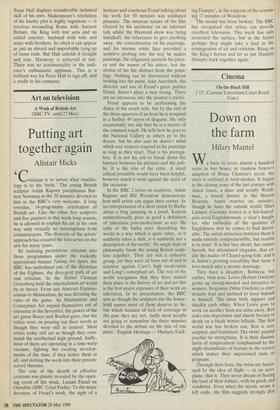Art on television
Putting art together again
Alistair Hicks
Criticism is to artists what ornitho- logy is to the birds.' The young British sculptor Anish Kapoor paraphrases Bar- nett Newman in the 20 minutes devoted to him in the BBC's very welcome, if long overdue, 14-programme celebration of British art. Like the other five sculptors and five painters in this week-long season, he is allowed to explain his art in his own way with virtually no interruptions from commentators. The diversity of the artists' approach has ensured the best series on the arts for many years.
By isolating pretentious criticism into three programmes under the wickedly appropriate banner Taking Art Apart, the BBC has underlined one of the dilemmas of the Eighties, the divergent path of art and criticism. In the Sixties Clement Greenberg held the international art world by its throat. From late Abstract Express- ionism to Minimalism, he was dictating the rules of the game. As Minimalism and Conceptual Art argued themselves out of existence in the Seventies, the power of the art gurus Beuys and Warhol grew. but the critics went on pouring out their words as though they were still in control. Most critics today still act as though they com- mand the intellectual high ground. Sadly, most of them are operating in a time-warp vacuum, fighting the exciting develop- ments of the time, if they notice them at all, and slotting the work into their precon- ceived theories.
The cost of the dearth of effective criticism was plainly revealed by the open- ing event of the week, Lucian Freud on Omnibus (BBC 1) last Friday. To the many devotees of Freud's work, the sight of a
hesitant and courteous Freud talking about his work for 50 minutes was undiluted pleasure. The amateur nature of the film (forced by his insistence on an informal talk whilst the Hayward show was being installed), the reluctance to give anything away, the concentration on his paintings, and his intense white face provided a sensitive probing into the way he makes paintings. He religiously protects his priva- cy and the names of his sitters, lest the stories of his life distract from the paint- ings. Nothing can be discovered without looking into the paint. Jake Auerbach, the director and son of Freud's great painter friend, doesn't place a step wrong. There are no intrusions into the painter's cricles.
Freud appears to be performing the dance of the seven veils, but by the end of the three-quarters of an hour he is wrapped in a further 49 layers of disguise. He only occasionally lets slip that he is a master of the common touch. He tells how he goes to the National Gallery as others go to the doctor, but he also says he doesn't mind which way viewers respond to his paintings as long as they react. That is his preroga- tive. It is not his job to break down the barriers between his pictures and the pub- lic. It is the role of the critic. A small critical preamble would have been helpful, however much it went against the spirit of the occasion.
In the BBC 2 series on sculptors, Anish Kapoor and Bill Woodrow demonstrate how well artists can argue their corner. In his interpretation of a short poem by Basho about a frog jumping in a pond, Kapoor unintentionally gives as good a definition of 'pluralistic post-modernism' as any. He talks of the haiku poet 'describing the world in a way which is quite other, so it suddenly takes a shift, it is suddenly not a description of the world.' No single style of philosophy binds the young British sculp- tors together. They are not a cohesive group, yet they were all born out of and in reaction against Caro's high modernism and Long's conceptual art. The rest of the world recognises that they have staked their place in the history of art and yet this is the first major exposure of their work on television. In its presentation, the BBC acts as though the sculptors are the house- hold names most of them deserve to be, but which because of lack of coverage in the past they are not. Sadly most people are going to remember the three minutes devoted to the debate on the title of one piece, 'English Heritage — Humpty Fuck-
ing Dumpty', at the expense of the remain- ing 17 minutes of Woodrow.
The mould has been broken. The BBC has recognised that artists can provide excellent television. This week has only scratched the surface, but in the future perhaps they might take a lead in the reintegration of art and criticism. Bring on the King's horses and let us put Humpty Dumpty back together again.


















































 Previous page
Previous page